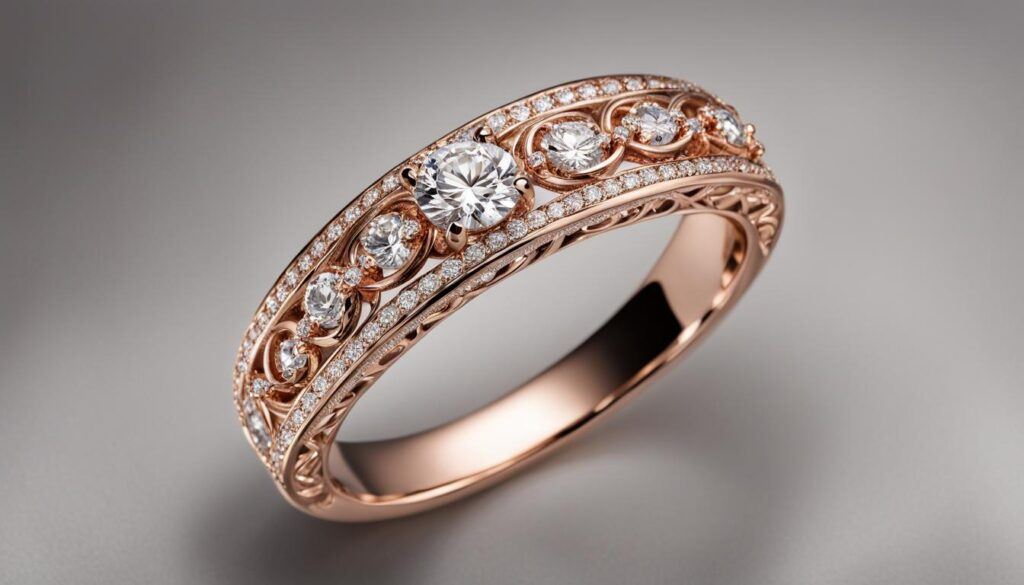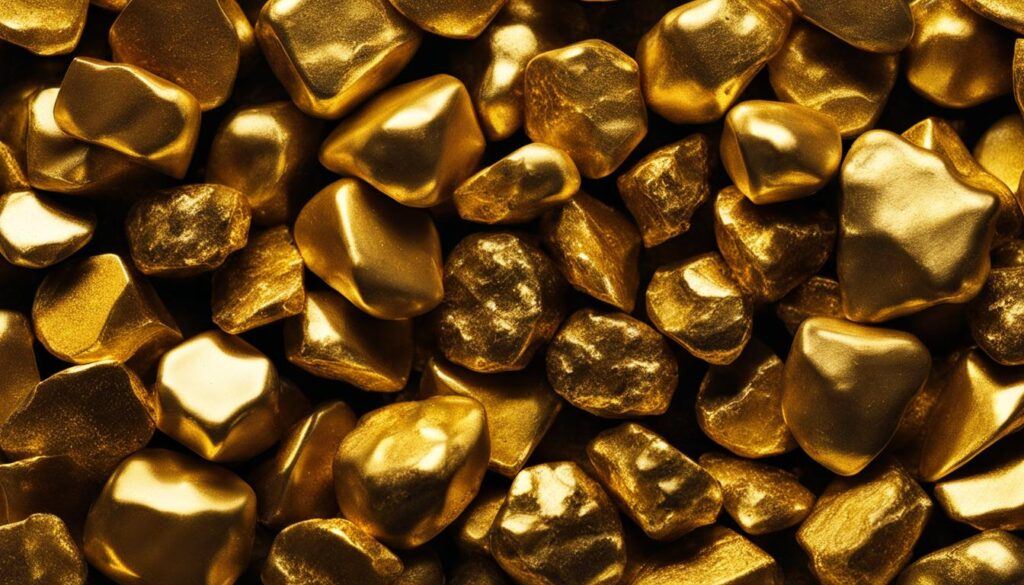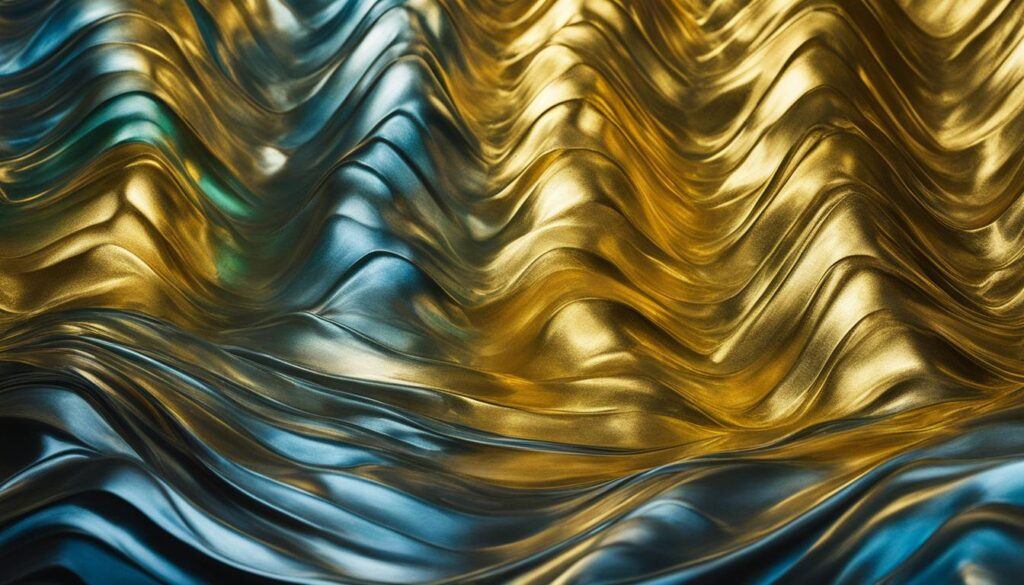Gold is a precious metal that captures our attention with its stunning beauty and elegance. But have you ever wondered why gold comes in different shades and colors? The answer lies in the composition of gold jewelry, which is rarely made from pure gold. Instead, it is mixed with various alloys to enhance its durability and create a wide range of color variations.
The combination of different metals with gold produces distinct shades, including yellow, white, rose, green, grey, purple, blue, and even black. These variations in color make gold jewelry even more alluring, as they cater to different preferences and styles.
So, what factors contribute to these mesmerizing gold color variations? It all comes down to the alloys used and the specific ratios in which they are mixed with gold. The addition of certain metals like silver, copper, zinc, platinum, palladium, aluminum, gallium, indium, iron, nickel, and even toxic cadmium determines the final color of the gold.
Key Takeaways:
- Gold jewelry is rarely pure gold and is usually mixed with other metals to create different shades.
- The most common colors of gold are yellow, white, and rose, but there are also lesser-known shades like green, grey, purple, blue, and black.
- Yellow gold is the natural color of gold and is achieved by mixing gold with silver, copper, and zinc.
- White gold is created by combining gold with metals like platinum, palladium, and nickel.
- Rose gold gets its pink hue from the addition of copper, and it is often more affordable than other gold shades.
Shades of Gold
Gold jewelry comes in a variety of shades due to the different alloys mixed with gold. Let’s explore the various shades of gold and the alloys that create them.
Yellow Gold
Yellow gold is the natural color of gold and is created by mixing gold with silver, copper, and zinc. This traditional and timeless shade has been adored for centuries.
White Gold
White gold is made by mixing gold with platinum, palladium, nickel, and other metals. This alloy creates a beautiful silvery shade that complements various gemstones and has gained popularity in recent years.
Rose Gold
Rose gold gets its pink tint from the addition of copper. The warm and romantic hue of rose gold has become increasingly sought after and is often used in engagement rings and other fine jewelry pieces.
Green Gold
Also known as electrum, green gold is a mixture of gold and silver. This unique shade has a subtle greenish tint that adds a touch of elegance to jewelry designs.
Grey Gold
Grey gold is made from gold and palladium, often used as an alternative to white gold. Other alloys, such as silver, manganese, and copper, can also be used to create this trendy and modern shade.
Purple Gold
Purple gold, also known as amethyst gold or violet gold, is an alloy of gold and aluminum. The vibrant purple color creates a striking and unconventional look.
Blue Gold
Blue gold can be achieved by mixing gold with gallium or indium. Another method involves an alloy of gold, iron, and nickel, which is then heat-treated to obtain a superficial blue color. This captivating shade is sure to make a statement.
Black Gold
Black gold is a rare and intriguing shade that can be achieved through various methods such as patination or controlled oxidation. This dark and mysterious color adds a touch of drama to any jewelry piece.
As you can see, the world of gold offers a wide spectrum of shades, from the classic yellow and white gold to the more unique rose, green, grey, purple, blue, and black gold. Each shade has its own distinct beauty and allure, allowing you to choose the perfect gold color to express your style and personality.
White Gold
White gold is a popular choice for jewelry enthusiasts who appreciate its sleek and sophisticated appearance. This elegant metal is created by mixing gold with other metals such as platinum, palladium, nickel, cadmium, or zinc. By blending these alloys, white gold achieves a stunning white hue that resembles the color of platinum, while offering a more affordable alternative to both yellow gold and platinum.
One of the key benefits of white gold is its durability and scratch-resistant properties. The addition of platinum and palladium enhances the strength of the gold, ensuring that white gold jewelry can withstand the wear and tear of daily use. Moreover, the inclusion of nickel or zinc in the alloy mixture provides white gold with a lustrous shine that enhances the visual appeal of the jewelry piece.
To achieve an even brighter and whiter color, white gold jewelry is often rhodium plated. Rhodium, a precious metal belonging to the platinum group, is used to add a protective layer to the jewelry, enhancing its shine and preventing tarnish. This plating process not only enhances the aesthetic appeal of white gold but also ensures its long-lasting beauty.
| Advantages of White Gold | Disadvantages of White Gold |
|---|---|
| 1. Beautiful and modern appearance | 1. Requires occasional maintenance and re-plating |
| 2. Durable and scratch-resistant | 2. Contains nickel, which may cause allergies in some individuals |
| 3. More affordable than yellow gold and platinum | 3. Prone to discoloration if not properly cared for |
White gold offers a timeless beauty and versatility that makes it suitable for various styles of jewelry, including engagement rings, necklaces, bracelets, and earrings. Whether you prefer a classic or contemporary design, white gold jewelry is sure to add a touch of elegance to any ensemble.
Overall, white gold combines the beauty of gold with the durability and affordability of other metals. Its white color and sophisticated appeal make it a sought-after choice for those who desire a modern and luxurious jewelry piece.
Did you know?
“White gold jewelry is often more affordable than platinum or yellow gold jewelry, making it a cost-effective choice for those seeking a luxurious look without breaking the bank.”

Yellow Gold
Yellow gold is the natural color of gold and is achieved through a combination of silver, copper, and zinc with gold itself. This classic gold shade is known for its warm and lustrous appearance. It is the most hypoallergenic option among the different shades of gold, making it suitable for those with sensitive skin.
One of the advantages of yellow gold is its low maintenance. Unlike white gold, which requires regular re-plating, yellow gold retains its color over time and does not need any additional treatments or maintenance to preserve its appearance.
When it comes to jewelry, yellow gold has long been a popular choice. It complements a wide range of gemstones, including diamonds, pearls, and colored gemstones, making it versatile and suitable for various types of jewelry.
Yellow gold is also highly durable, thanks to the inclusion of alloys such as silver, copper, and zinc. These alloys add strength and resilience to the gold, ensuring that it can withstand everyday wear and tear without significant damage.
I love the rich and vibrant look of yellow gold. It adds a timeless elegance to any jewelry piece and is perfect for both classic and contemporary styles.
Benefits of Yellow Gold:
- Hypoallergenic: Yellow gold is the most hypoallergenic option among different shades of gold, making it suitable for those with sensitive skin.
- Low maintenance: Unlike white gold, yellow gold does not require regular re-plating to maintain its color.
- Durable: The inclusion of alloys such as silver, copper, and zinc adds strength and durability to yellow gold jewelry.
- Versatile: Yellow gold complements a wide range of gemstones and jewelry styles.
Yellow Gold Composition:
| Alloy | Composition |
|---|---|
| Silver | Up to 30% |
| Copper | Up to 15% |
| Zinc | Up to 5% |
| Gold | Remaining percentage |
Yellow gold’s composition typically includes up to 30% silver, up to 15% copper, up to 5% zinc, with the remaining percentage being pure gold. These alloys are carefully blended to achieve the desired shade of yellow gold.
Whether you’re looking for a classic gold engagement ring, a timeless necklace, or a statement bracelet, yellow gold is a versatile and durable option that will never go out of style.
Rose Gold
Rose gold is a stunning gold alloy that gets its distinctive pink tint from the addition of copper, along with a touch of silver. This beautiful color variation has been gaining popularity in recent years, especially in the world of jewelry and fashion.
One of the reasons rose gold has become a sought-after choice is its affordability. The addition of copper, which is less expensive than other metals used in gold alloys, makes rose gold a more budget-friendly option compared to other shades of gold.
Another name for rose gold is “Russian gold.” This name reflects its association with Russian jewelry traditions, where rose gold has long been a popular choice. Russian gold is known for its warmth and elegance, and rose gold perfectly embodies these qualities.
Now, let’s take a closer look at the composition of rose gold:
Rose gold is created by combining gold with copper and silver. The copper content gives it the beautiful pink hue, while the addition of silver helps to enhance its shine and brilliance.
To get a better understanding, here is a breakdown of the composition of rose gold:
| Metal | Percentage |
|---|---|
| Gold | 75% |
| Copper | 22.5% |
| Silver | 2.5% |
As you can see, the copper content is significantly higher than the silver content, contributing to the predominant pink color of rose gold.
Whether you’re looking for a romantic piece of jewelry or a trendy accessory, rose gold offers a unique option that stands out from traditional yellow gold and white gold. Its warm tones and affordability make it a popular choice for engagement rings, bracelets, necklaces, and other jewelry pieces.

Green Gold
Green gold, also known as electrum, is a naturally occurring alloy of silver and gold. The modern composition of green gold includes silver and sometimes copper. Cadmium can also be added to create a green color, but it is toxic.
| Metal | Composition |
|---|---|
| Gold | 50-80% |
| Silver | 20-50% |
| Copper | 0-5% |
| Cadmium | 0-2% (toxic) |
In ancient times, electrum was often used to make coins due to its natural occurrence and durability. Today, green gold is primarily used in jewelry, particularly in the creation of unique, nature-inspired designs.
Grey Gold
Grey gold is a unique shade of gold that offers a modern and sophisticated twist to traditional gold jewelry. While it is often made from a combination of gold and palladium, there are also cheaper alternatives that include silver, manganese, and copper in the alloy mixture. Some forms of grey gold even incorporate iron, adding to its distinctive appearance.
Grey gold’s composition gives it a cool and contemporary aesthetic, making it an attractive choice for those seeking a bold and unconventional look. Its subtle grey hue sets it apart from other shades of gold, allowing wearers to express their individuality and personal style.
One interesting aspect of grey gold is its versatility. It can be used to create various types of jewelry, from rings and necklaces to bracelets and earrings. Whether worn as a statement piece or combined with other metals and gemstones, grey gold adds a touch of sophistication and uniqueness to any design.
To better understand the composition of grey gold, take a look at the table below:
| Alloy | Composition |
|---|---|
| Gold and Palladium | Primary components |
| Silver | Alternative alloy option |
| Manganese | Alternative alloy option |
| Copper | Alternative alloy option |
| Iron | Possible additional component |
Grey gold’s unique composition and striking appearance make it a popular choice among those seeking a non-traditional yet elegant piece of jewelry. Whether you’re looking for a stunning engagement ring or a stylish accessory to complement your everyday look, grey gold offers a contemporary twist on classic gold jewelry.
Emphasized Quote:
“Grey gold’s cool and sophisticated hue adds a touch of modernity to any jewelry design.” – Jewelry Expert
Purple Gold
Purple gold, also known as amethyst gold or violet gold, is an alloy of gold and aluminum. Compared to other gold alloys, purple gold is more brittle and typically used as an encrustation on conventional gold jewelry. Its unique purple hue adds a touch of elegance and sophistication to any piece.
When gold is combined with aluminum, it undergoes a molecular rearrangement, resulting in the formation of purple gold. The exact shade of purple can vary depending on the ratio of gold to aluminum in the alloy. The addition of aluminum gives the gold a distinctive purple color, making it stand out among other gold varieties.
“Purple gold combines the luxurious appeal of gold with the captivating allure of the color purple.”
This exquisite gold alloy is often used in jewelry, particularly in the form of accents or embellishments. Its unique color makes it a popular choice for those seeking a statement piece that goes beyond traditional gold colors. Whether it’s an amethyst gold pendant, a violet gold ring, or a pair of purple gold earrings, this distinctive alloy offers a stunning and vibrant alternative to more conventional gold options.
When working with purple gold, jewelers need to consider its brittleness. While gold is a malleable metal, the addition of aluminum makes the resulting alloy more fragile and prone to cracking or breaking. Therefore, purple gold is often used in small quantities or as a decorative feature rather than the primary material for jewelry.
Now, let’s take a moment to appreciate the allure of purple gold with an image showcasing its beauty:
As the image above illustrates, the captivating hue of purple gold adds a touch of sophistication and uniqueness to any piece of jewelry.
Next, we’ll delve into the intriguing world of gold color variations, exploring the diverse spectrum of gold shades and their distinct characteristics.
Blue Gold
In the world of gold alloys, one fascinating shade stands out—blue gold. This unique color can be achieved through two different methods, both resulting in a captivating blue hue that sets it apart from traditional gold tones.
The first method involves mixing gold with gallium or indium. When combined, these elements create a beautiful blue color that adds a touch of intrigue to gold jewelry and other decorative items.
The second method of obtaining blue gold is through the use of an alloy consisting of gold, iron, and nickel. This alloy is then heat-treated, resulting in a superficial blue color that is visually striking.
The mesmerizing allure of blue gold makes it a sought-after choice for individuals looking for unique and eye-catching jewelry pieces. Whether it’s a dazzling blue gold necklace or a stunning blue gold ring, this distinct color adds a touch of sophistication and individuality to any ensemble.

With its captivating shade and the use of innovative alloys, blue gold represents an exciting and modern twist on traditional gold jewelry. Its distinctive color and luxurious appeal make it a standout choice for those seeking to make a statement with their accessories.
Black Gold
Black gold is the rarest of the exotic gold colors. Its captivating allure stems from unique production methods, such as patination or controlled oxidation, which result in a striking black hue. These techniques involve the introduction of compounds containing sulfur and oxygen or the controlled oxidation of gold containing chromium or cobalt. The resulting color adds a touch of sophistication and elegance to any piece of jewelry.
Black gold’s distinct appearance sets it apart from traditional gold shades, making it a sought-after choice for those who desire a statement piece. Whether it is a sleek black gold ring or a stunning black gold necklace, this exquisite color exudes a sense of mystery and individuality.
Properties of Black Gold:
| Color | Composition | Features |
|---|---|---|
| Black | Gold with compounds containing sulfur and oxygen or gold containing chromium or cobalt | Dramatic, elegant, rare |
Black gold offers a distinct alternative to traditional gold colors. Its unique composition and dark hue make it a perfect choice for those who want to stand out from the crowd and embrace a more unconventional style.
Popular Gold Colors
When it comes to gold jewelry, three colors stand out as the most popular choices: yellow gold, white gold, and rose gold. Each color has its unique charm and appeal, catering to different preferences and styles.
The Allure of Yellow Gold
Yellow gold is the classic, natural color of gold. It exudes elegance and timeless beauty. Created by mixing gold with alloys such as silver, copper, and zinc, yellow gold captures the essence of luxury and tradition. Its warm, vibrant hue has adorned jewelry for centuries, symbolizing wealth and status.
“Yellow gold showcases the true essence of gold, radiating a sense of opulence and sophistication.”
The Rise of White Gold
In recent years, white gold has gained incredible popularity among jewelry enthusiasts. Made by mixing gold with metals like platinum, palladium, nickel, or zinc, white gold offers a sleek and modern alternative to traditional yellow gold. Its lustrous, silvery appearance complements a wide range of gemstones, making it a versatile choice for any occasion.
“White gold’s crisp, cool hue adds a contemporary edge to any jewelry piece, making it a favorite among fashion-forward individuals.”
The Enchanting Beauty of Rose Gold
Rose gold has become a beloved option for those seeking a touch of romance and elegance in their jewelry. Achieved by adding copper to the gold alloy, rose gold exhibits a soft pink hue that is both feminine and alluring. Its warm and romantic appeal makes it a popular choice for engagement rings, bracelets, and other statement pieces.
“Rose gold’s gentle blush color evokes a sense of grace and femininity, making it a perfect choice for those who appreciate romance and individuality.”
Popular Gold Colors at a Glance
| Gold Color | Description |
|---|---|
| Yellow Gold | The natural color of gold, symbolizing tradition and luxury. |
| White Gold | A contemporary and versatile alternative to yellow gold. |
| Rose Gold | A romantic and feminine choice, with its soft pink hue. |

Conclusion
In conclusion, the variations in gold color are fascinating and diverse. Through the mixing of different alloys like silver, copper, platinum, palladium, and aluminum, gold can take on a range of shades. From traditional yellow and white gold to trendy rose, green, grey, purple, blue, and even black gold, each color has its own distinct properties and appeal.
Understanding the different shades of gold is essential when buying or selling gold jewelry. Whether you are drawn to the timeless elegance of yellow gold, the modern sophistication of white gold, or the romantic allure of rose gold, knowing the properties and characteristics of each color can help you make an informed choice that suits your personal style.
When it comes to gold jewelry, there is a color variation for every taste and occasion. From classic to contemporary, the different shades of gold offer endless possibilities to express your unique individuality. So, whether you prefer the warmth of yellow gold or the coolness of white gold, explore the diverse world of gold colors and find the perfect hue that resonates with you.
FAQ
Why does gold come in different colors?
Gold comes in different colors due to the mixing of alloys with gold. Different metals, such as silver, copper, platinum, palladium, and aluminum, create various colors ranging from yellow to white, rose, green, grey, purple, blue, and black.
What are the different shades of gold?
The different shades of gold include yellow, white, rose, green, grey, purple, blue, and black.
What is white gold made of?
White gold is made by mixing gold with platinum, palladium, nickel, cadmium, or zinc. This creates a durable and scratch-resistant gold color that is more affordable than yellow gold and platinum. To achieve a bright white color, white gold jewelry is often rhodium plated.
How is yellow gold created?
Yellow gold is the natural color of gold and is achieved by mixing gold with silver, copper, and zinc. It is the most hypoallergenic and requires the least maintenance among the different shades of gold.
What gives rose gold its pink tint?
Rose gold gets its pink tint from the addition of copper, as well as a bit of silver. Due to the use of inexpensive copper, rose gold is more affordable than other shades of gold. It is also known as Russian gold.
How is green gold made?
Green gold, also known as electrum, is a naturally occurring alloy of silver and gold. The modern composition of green gold includes silver and sometimes copper. Cadmium can also be added to create a green color, but it is toxic.
What is grey gold made from?
Grey gold is often made from gold and palladium, although cheaper alternatives may include silver, manganese, and copper. Some forms of grey gold also use iron in the alloy mixture.
What is purple gold?
Purple gold, also known as amethyst gold or violet gold, is an alloy of gold and aluminum. It is more brittle than other gold alloys and is often encrusted in conventional gold jewelry.
How is blue gold achieved?
Blue gold can be achieved by mixing gold with gallium or indium. Another method involves an alloy of gold, iron, and nickel, which is then heat-treated to obtain a superficial blue color.
How is black gold produced?
Black gold is the rarest of the exotic gold colors. It can be produced through methods such as patination with compounds containing sulfur and oxygen, controlled oxidation of gold containing chromium or cobalt, and more.
What are the most popular gold colors?
The most popular gold colors are yellow gold, white gold, and rose gold. Yellow gold has seen a decrease in popularity due to increasing gold prices, while white gold has become widely used in recent years. Rose gold is also gaining popularity for its unique pink hue.
Why should I understand the different shades of gold?
Understanding the different shades of gold can help in making informed choices when buying or selling gold jewelry. It allows you to choose a color that suits your preferences and complements your style.
How do the different shades of gold vary in properties?
Each shade of gold has its own unique properties. For example, white gold is durable and scratch-resistant, while yellow gold is hypoallergenic and low-maintenance. The properties of gold colors can influence their suitability for different purposes and personal preferences.



